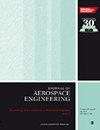Development and evolution mechanism of streamwise vortex in an inward-turning inlet
IF 1
4区 工程技术
Q3 ENGINEERING, AEROSPACE
Proceedings of the Institution of Mechanical Engineers Part G-Journal of Aerospace Engineering
Pub Date : 2023-08-17
DOI:10.1177/09544100231194882
引用次数: 0
Abstract
The three-dimensional flows in an inward-turning inlet were numerically investigated at different incoming flow conditions. When the incoming flow conditions change, the shock angle and the shock interaction form of the external compression wave change, and the development of the near-wall low-energy fluid and the streamwise vortex is also affected. The impingement of the shock wave leads to a sharp increase in the vorticity of the low kinetic energy fluid. Under the pressure gradient caused by the shock wave, the high-vorticity fluid migrates from the cowl to the ramp and entrains the mainstream fluid to form a streamwise vortex, for which the velocity gradient ( ∂v/ ∂y + ∂w/ ∂z) along the vortex axis can accurately determine the rotation direction and the Hopf bifurcation position. By considering high Reynolds number flows, the pressure gradient along the vortex axis is developed to estimate the simplified dilation term (velocity gradient) due to its ease of measurement. However, the pressure gradient ( ∂p/ ∂x) along the vortex axis can lead to bias when evaluating the cross-flow state of the streamwise vortex, with the shock wave structure and high-vorticity fluid leading to under- and overestimation, respectively. This study provides a theoretical basis for an accurate determination of the flow state of a streamwise vortex in an inward-turning inlet and thus lays the foundation for effective vortex control.内旋进气道内向涡的形成与演化机制
对不同来流条件下内旋进气道内的三维流动进行了数值研究。当来流条件改变时,外压缩波的激波角和激波相互作用形式发生变化,影响近壁低能流体和流向涡的发展。激波的冲击使低动能流体的涡度急剧增大。在激波造成的压力梯度下,高涡度流体从整流口向坡道迁移,夹带主流流体形成顺流涡,沿涡轴的速度梯度(∂v/∂y +∂w/∂z)可以准确确定旋转方向和Hopf分岔位置。考虑高雷诺数流动,由于其易于测量,采用沿涡轴的压力梯度来估计简化膨胀项(速度梯度)。然而,沿涡轴的压力梯度(∂p/∂x)在评估顺流涡的横流状态时可能导致偏差,激波结构和高涡度流体分别导致低估和高估。本研究为准确确定内旋进气道内向涡的流动状态提供了理论依据,为有效控制涡奠定了基础。
本文章由计算机程序翻译,如有差异,请以英文原文为准。
求助全文
约1分钟内获得全文
求助全文
来源期刊

CiteScore
2.40
自引率
18.20%
发文量
212
审稿时长
5.7 months
期刊介绍:
The Journal of Aerospace Engineering is dedicated to the publication of high quality research in all branches of applied sciences and technology dealing with aircraft and spacecraft, and their support systems. "Our authorship is truly international and all efforts are made to ensure that each paper is presented in the best possible way and reaches a wide audience.
"The Editorial Board is composed of recognized experts representing the technical communities of fifteen countries. The Board Members work in close cooperation with the editors, reviewers, and authors to achieve a consistent standard of well written and presented papers."Professor Rodrigo Martinez-Val, Universidad Politécnica de Madrid, Spain
This journal is a member of the Committee on Publication Ethics (COPE).
 求助内容:
求助内容: 应助结果提醒方式:
应助结果提醒方式:


